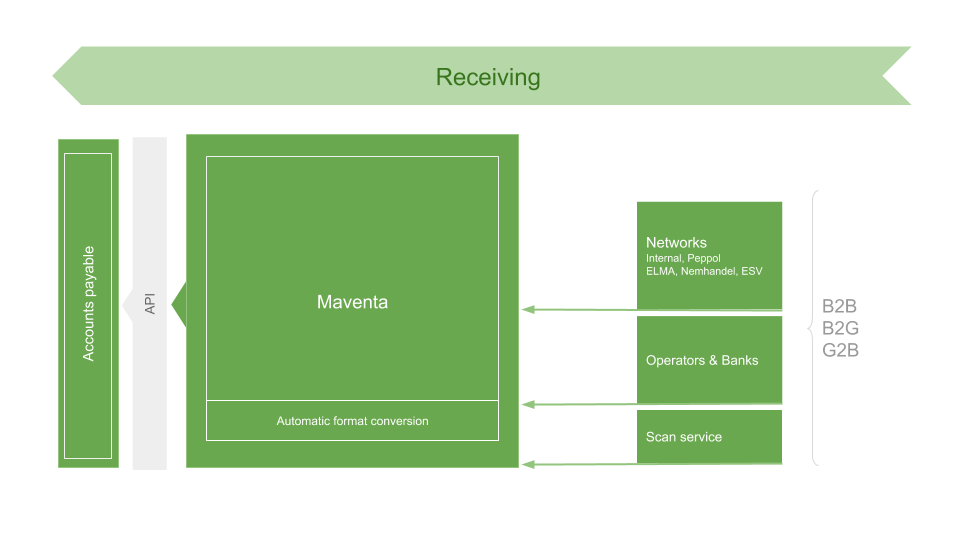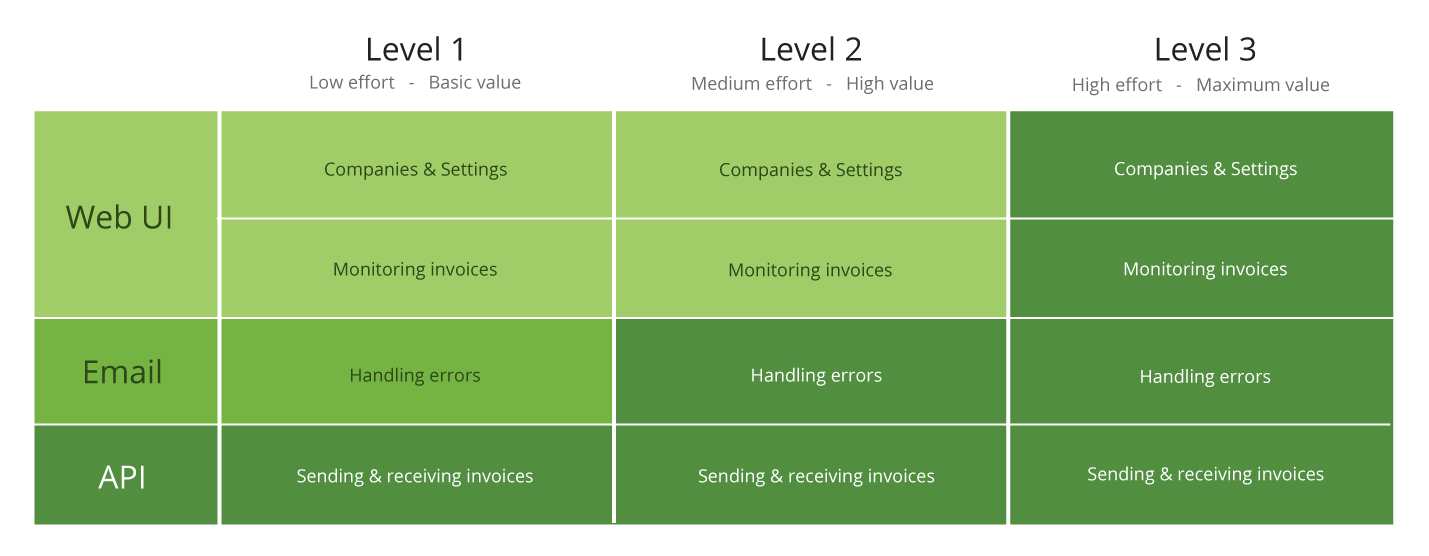Maventa Service
What is Maventa?
Maventa offers electronic invoicing and document transfer services for companies and public organizations.
The service can be thought of as an electronic postal office that acts as a connector between suppliers and buyers and their systems. In addition to electronic business document delivery, Maventa supports a variety of value added services for invoicing and related financial processes.
There are two APIs that can be used for connecting to Maventa, REST and SOAP. Both can be used, but note that all the functionality is not available over the SOAP API
- REST
Maventa REST API gives access to account management and Maventa’s e-invoicing services. It is also used for other business document traffic like order document exchange. The API allows also connecting to a growing number of advanced functions and services for P2P and O2C. - SOAP
Maventa SOAP API gives access to account management and Maventa’s e-invoicing services.
What can the APIs be used for?
- Electronic invoicing B2B/B2G/G2B
- Consumer invoicing to netbank and mobile applications
- Electronic ordering and other e-document delivery
- Connection to value added services for P2P and O2C
- Custom applications and import tools
Maventa e-invoicing overview


What type of integration to make
There are different ways to integrate to Maventa and the selection of offered services. The following guide will help you decide and defined what you want from your integration.
Integration scope
The integration scope impacts what Maventa services you integrate to. The scope defines what are the key functionalities and capabilities users will have in the service.
Things to consider when defining the scope:
-
Sending, receiving or both?
Will your customers be using Maventa to send or to receive electronic documents or for both. -
B2B / B2C invoicing?
Do your customers have needs for consumer invoicing. Maventa has different consumer invoicing options between the market areas, delivering to bank network or mobile application depending on country. -
Additional services?
What are the services your customers want to activate? We have different services that support the invoicing flow, such as printing and scan service as well as help to bring customers added value such as Receivables Management and Supplier Activation. See Services & Networks part in Integration guide for more information.
Integrators can either use the REST API or the legacy SOAP API. Going forward, only the REST API will expose new features and improvements.
Integration level
In terms of development effort, integrating with Maventa can range from using just a few API endpoints to a fully fledged out and complex solution. The higher the integration level, the more feature rich your solution will be while at the same time requiring more development effort to achieve (for example will the users access Maventa UI or will all actions take place within your ERP system).
Integration levels from level 1 to level 3 are shown on the picture below, level 3 offering the highest value at a proportionate development cost.

In level 1, invoice sending and receiving takes place through our API but email and web UI are used to handle errors, monitor invoices and manage companies and settings.
When the level of integration goes up the level of automation can also increase. In level 3, all actions from invoice sending, receiving and monitoring to error handling and company management are handled through the API.
The level should be chosen based on the integrators needs and the amount of automation required. It is also good to note that you can start from a level and continue to deepen the integration over time.
Quick guide to e-invoicing
Interested to know more about electronic invoicing? Here’s our quick guide to the basics of electronic invoicing and document exchange.
What is an electronic invoice and an electronic order document?
An electronic invoice or order document is a document that is exchanged over a network between two or more independent financial systems requiring no human interference.
Electronical invoicing and ordering (or e-invoicing and e-ordering) means that business documents such as invoices, credit notes, catalogues, orders and order responses are distributed between the supplier and the buyer in a structured, electronical format.
Why use electronic document exchange?
Electronic documents are an easy and effective way to deliver data between trading partners.
With electronic document exchange it is possible to change the traditionally paper-heavy manual processing of documents into a faster, more automated process and this way create signficant savings in cost and time.
Electronic document exchange also enables an increased level of integration between the supplier and the buyer, as well as between organization’s own accounting software and other business systems.
How e-invoicing and e-ordering works?
Electronic invoicing and ordering infrastructure consists of operators that connect suppliers and buyers referred as end customers. When an end customer sends an e-document, his/her operator routes it to the receiver.
Maventa e-invoicing
Maventa e-invoicing works based on trying to find the best possible route for the document. If the receiver cannot be reached through the e-invoicing network, the invoice can be sent as email or to printing services and delivered as a paper mail. This allows reaching of all customers through a single API.
E-document formats
There are different formats that are accepted as ways to structure the data for the electronic documents such as invoice. E-document can be data in structured Electronic Data Interchange (EDI) or XML format, or structured data issued using standard web-based forms.
Maventa and e-document formats
Maventa e-invoicing supports XML based standard formats and automatically converts the invoices from one format to another when needed. The service supports a wide range of different e-invoicing formats including international ones like PEPPOLBIS, formats for software houses like VismaXML and LiinosXML, and national formats like Finvoice, TEAPPSXML (FI), Svefaktura (SE) and SI-UBL (NL). If you are downloading invoices please check that your financial system can handle at least one of the formats that Maventa supports. For e-ordering Maventa uses Peppol formats.
Learn more about invoice formats:
E-document networks
E-document networks enable trading partners to exchange standards-based electronic documents between each other over a common network. The networks can be open or point to point connections between different operators.
In addition to operator point-to-point connections, Maventa enables connection to the open European e-delivery network Peppol. Peppol is part EU’s initiative to move document exchange between economic operators to standardised electronic form and to lower the barrier for cross-border trading. Peppol has expanded from EU to a global network, including for example Singapore.
Users are connected to the Peppol network over Access Points. Maventa is a certified Peppol Access Point provider. This means that through Maventa you can register companies to Peppol network for receiving electronic documents and send electronic documents to other Peppol recipients. You can read more about Peppol here.
Registering to Peppol via Maventa is explained in our integration guide.
Routing of e-documents
Documents are routed based on the recipient and operator/network information. Depending on how the document is delivered, this address can be the electronic invoice address (EIA), email or postal address. If no address is given Maventa can try to fill in the information based on the recipient’s business ID and information in Maventa Finder. The finder uses information from different sources, like national registers for e-invoice addresses. The default order in which invoices are sent is e-invoice, email, print. In Maventa there are also possibilities for customized routing, i.e. disabling routes or changing their order.